Wireless Infrastructure Monitoring Market Size
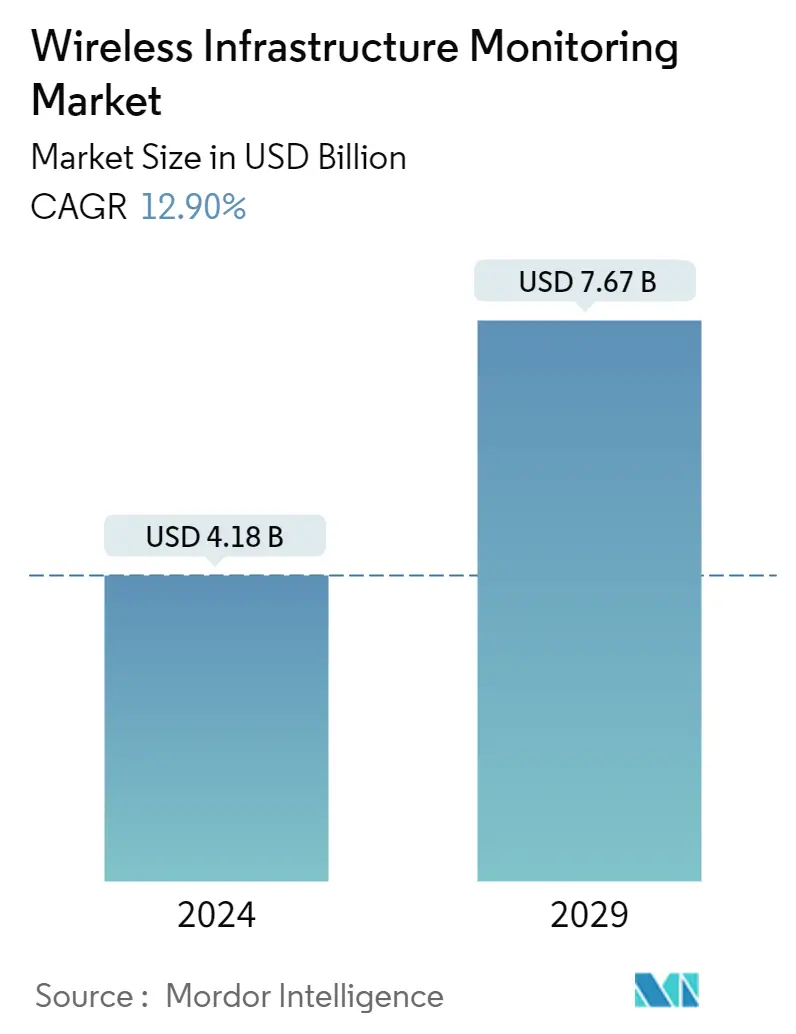
| Study Period | 2019 - 2029 |
| Market Size (2024) | USD 4.18 Billion |
| Market Size (2029) | USD 7.67 Billion |
| CAGR (2024 - 2029) | 12.90 % |
| Fastest Growing Market | Asia Pacific |
| Largest Market | North America |
Major Players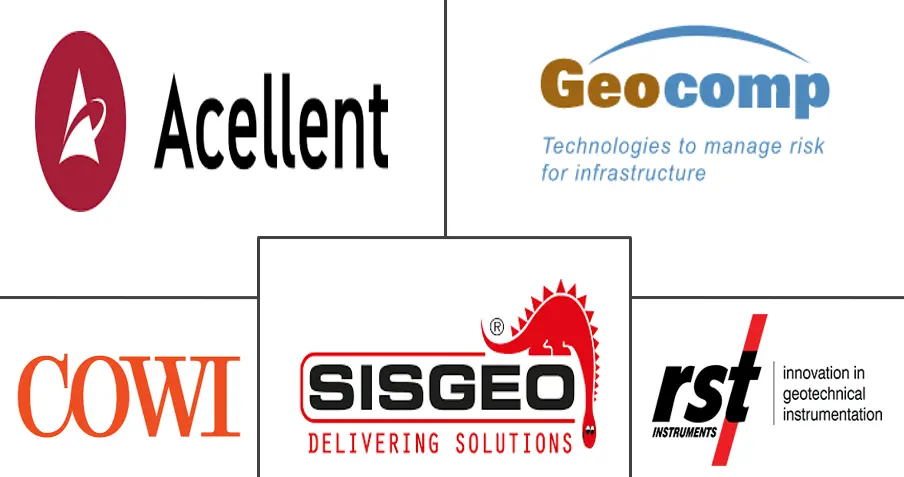
*Disclaimer: Major Players sorted in no particular order |
Wireless Infrastructure Monitoring Market Analysis
The Wireless Infrastructure Monitoring Market size is estimated at USD 4.18 billion in 2024, and is expected to reach USD 7.67 billion by 2029, growing at a CAGR of 12.90% during the forecast period (2024-2029).
The rapid advancements in technologies such as sensor technology, wireless technology, and IoT, which provide real-time information on structural conditions and health of infrastructures is driving the market.
- Owing to the strengthening economy, most of the countries are experiencing positive influence of industrialization and witnessing exuberant growth in their convoy of civil infrastructures such as roadways, highways, bridges, industrial warehouses, energy plants, and mining areas which are expected to boost the wireless infrastructure monitoring market.
- For instance, in 2019, China invested more than USD 125 billion for the construction of a high-speed rail network. China Railway Corporation is set to open 6,800 km of new lines, including 4,100 km of high-speed infrastructure, which is 45% more than the total mileage commissioned in 2018. By the end of 2018, it was operating 29,000 km of high-speed lines, two-thirds of the world, and had added more than 4000 route-km in 2018. It has reduced the travel time between major Chinese cities, and authorities are looking to extend new lines into some of the remote corners of the country.
- Moreocer, an increasing number of collapsing infrastructures due to deterioration has fueled the infrastructure monitoring market in order to check its health in real-time to avoid any situations of persistent infrastructure breakdown. In 2017, the United States infrastructure was given a near-failing grade of D+ by an engineering association, that reflects light on the degrading quality of its infrastructure. The ASCE estimated that the United States needed to invest USD 4.59 trillion by 2025 to bring its infrastructure to an adequate B- grade, a figure about USD 2 trillion higher than current funding levels. This increasing funding on its infrastructure is also expected to boost the wireless infrastructure monitoring market.
Wireless Infrastructure Monitoring Market Trends
This section covers the major market trends shaping the Wireless Infrastructure Monitoring Market according to our research experts:
Structural Monitoring Segment is Expected To Grow Significantly
- Structural monitoring equipment is employed to provides continuous, real-time monitoring of the health of the infrastructure and detects any cracks that can develop unnoticed and worsen over time. As per the IOGP’s Global Production Report 2019, demand for oil and gas is at the peak, greater than ever before, with dramatic growth in Africa, Asia Pacific, the Middle East, and the Americas. This has fueled the investment in exploration and production of oil to meet the demand and supply. Many mid-sized players are forming a strategic alliance for the development of unconventional resources.
- For instance, In 2019, Ecopetrol and Occidental Petroleum Corp agreed to form a joint venture for the development of unconventional reservoirs in approximately 97,000 acres of the Permian Basin in the State of Texas which is one of the largest and most active oil basins in the United States, accounting for approximately 30 percent of the total U.S. oil production. It is expected to boost the demand for structural monitoring equipment in the oil and gas sector.
- Moreover, the growth of infrastructure monitoring system market is boosting due to the ongoing mega-trend of smart cities. An increasing number of people are moving to cities, spurring skyrocketing demand for resources and services in these urban centers. By 2025, 35 cities across the world will have a population of greater than 10 million people. Cities already consume 2/3 of the world’s energy and the majority of other resources such as water, housing facilities, reliability of energy and power, the quality of the air, and the flow of traffic, which will impact the quality of living. So, most of the urban cities are addressing the escalating demands and are looking over the Internet of Things (IoT) technology for the cutting-edge intelligence and flexibility necessary to help cities use resources more efficiently.
- For instance, Intel and The City of San Jose, CA collaborated on a public-private partnership project which implements Intel’s IoT Smart City Demonstration Platform to create environmental sustainability by using IoT technology to measure characteristics such as particulates in the air, noise pollution, and traffic flow and offer air quality, noise, transportation efficiency, health, and energy efficiency.
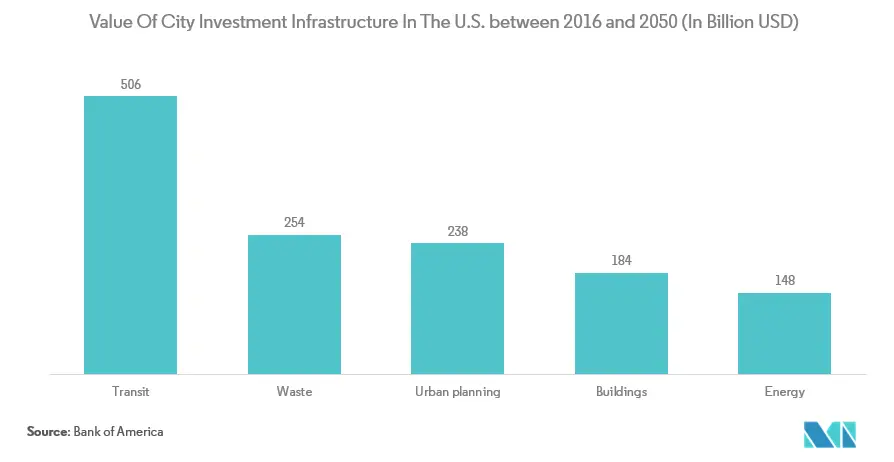
North America Will Experience Significant Growth and Drive the Market
- The rapid expansion of the end-user industries that offer a major opportunity for the application of wireless infrastructure monitoring systems is leading to the expansion of the market. For instance, United States has 98 operating nuclear power reactors in 30 states, and since 2001 these plants have achieved an average capacity factor of over 90%, generating up to 807 TWh per year and accounting for about 20% of the total electricity generated. The average capacity factor had risen from 50% in the early 1970s to 70% in 1991, and it passed 90% in 2002. The industry invests about USD 7.5 billion per year in maintenance and upgrades of the plants, which is expected to increase in upcoming years and is expected to drive the market.
- The players operating in the region are focusing on new product developments to increase their production capabilities. For instance, in October 2019, GSSI, United States-based ground penetrating radar (GPR) equipment manufacturer has introduced the new 200 MHz (200 HS) antenna, the first of the next-generation high-performance GS Series that is designed for applications that require deeper depth penetration. It is ideal for geophysical, geotechnical, or environmental applications that require high reliability under challenging survey conditions.
- However, the market is expected to be affected by the recent outbreak of the COVID-19 pandemic. The slowing down of the economy is expected to reduce expenditure on infrastructure and thereby to reduce growth figures for the market in a post-corona economy. However, the companies are expected to invest in their IT systems to develop remote monitoring capabilities in order to avoid a similar situation in the future. This is expected to act as a big stimulus for the market in the medium to long run.
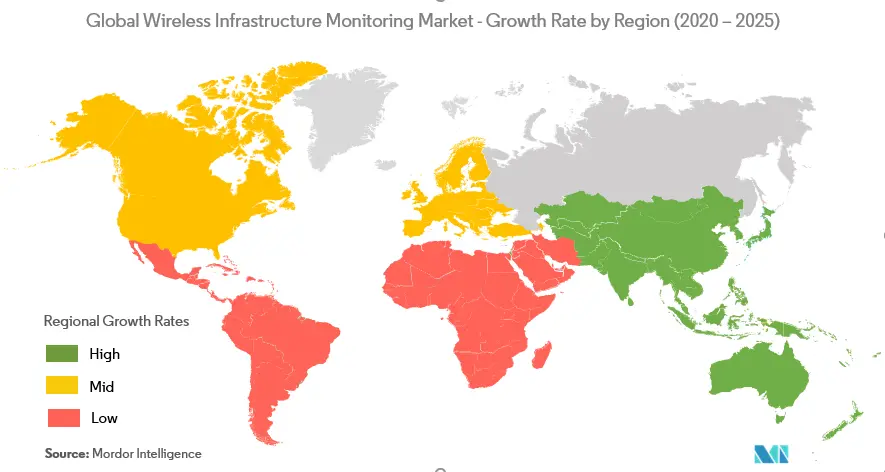
Wireless Infrastructure Monitoring Industry Overview
The wireless infrastructure monitoring market is highly competitive and consists of a few major players such as Acellent Technologies, Inc., Geocomp Corporation, COWI A/S, Sisgeo S.r.l. and RST Instruments Ltd (Vance Street Capital). These major players, with a prominent share in the market, are focusing on expanding their customer base across foreign countries. These companies are leveraging strategic collaborative initiatives to increase their market share and increase their profitability. However, with technological advancements and product innovations, mid-size to smaller companies are increasing their market presence by securing new contracts and by tapping new markets.
- June 2020 - COWI A/S won two framework agreements for VEAS, Norway's largest wastewater treatment plant. One covers building trades, including construction technology, fire safety, mechanical installations, outdoor environment, water, wastewater, stormwater, planning, environment, architecture, and HSE. The other is a separate framework agreement covering electrical installations and automation.
- May 2020 - Sisgeo. S.r.l. collaborated with Worldsensing leading wireless solution for geotechnical monitoring, so that its customers can enjoy automated readings when using Sisgeo's version 3 digital protocol sensors in combination with Worldsensing's, Loadsensing. It guarantees interoperability with Sisgeo borehole-profile in-place inclinometers, tiltmeters, rail deformation systems, extensometer probes, extenso-inclinometer probes, liquid settlement systems, load cells, and multipoint borehole extensometers, amongst others.
Wireless Infrastructure Monitoring Market Leaders
-
Acellent Technologies, Inc.
-
Geocomp Corporation
-
COWI A/S
-
Sisgeo S.r.l.
-
RST Instruments Ltd.(Vance Street Capital)
*Disclaimer: Major Players sorted in no particular order
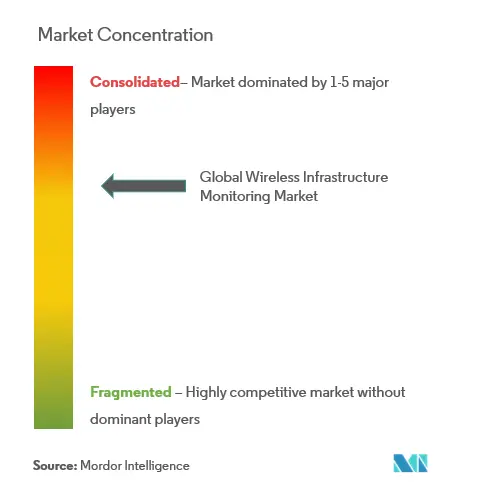
Wireless Infrastructure Monitoring Market Report - Table of Contents
1. INTRODUCTION
- 1.1 Study Assumptions and Market Definition
- 1.2 Scope of the Study
2. RESEARCH METHODOLOGY
3. EXECUTIVE SUMMARY
4. MARKET INSIGHT
- 4.1 Market Overview
-
4.2 Industry Attractiveness - Porter's Five Forces Analysis
- 4.2.1 Threat of New Entrants
- 4.2.2 Bargaining Power of Buyers/Consumers
- 4.2.3 Bargaining Power of Suppliers
- 4.2.4 Threat of Substitute Products
- 4.2.5 Intensity of Competitive Rivalry
- 4.3 Industry Value Chain Analysis
- 4.4 Assessment of Impact of COVID-19 on the Global Infrastructure Monitoring Market
5. MARKET DYNAMICS
-
5.1 Market Drivers
- 5.1.1 Stringent Government Regulations Pertaining to Sustainability of Structures
- 5.1.2 Cost-effective and Flexible Nature for Information Acquisition and Improving Maintenance Efficiency and Safety
-
5.2 Market Challenges
- 5.2.1 Shortage of Skilled Technicians for Installation and Calibration of Systems across Developing countries
6. MARKET SEGMENTATION
-
6.1 By Type
- 6.1.1 Hardware
- 6.1.2 Software and Services
-
6.2 By Application
- 6.2.1 Geotechnical Monitoring
- 6.2.2 Structural Monitoring
- 6.2.3 Environmental Monitoring
- 6.2.4 Other Applications (Spatial Monitoring, Traffic Flow Monitoring, etc.)
-
6.3 By End-user Industry
- 6.3.1 Civil Infrastructure
- 6.3.2 Oil and Refineries
- 6.3.3 Transportation
- 6.3.4 Mining
- 6.3.5 Others
-
6.4 By Geography
- 6.4.1 North America
- 6.4.2 Europe
- 6.4.3 Asia-Pacific
- 6.4.4 Rest of the World
7. COMPETITIVE LANDSCAPE
-
7.1 Company Profiles*
- 7.1.1 Acellent Technologies, Inc.
- 7.1.2 Geocomp Corporation
- 7.1.3 COWI A/S
- 7.1.4 Sisgeo S.r.l.
- 7.1.5 RST Instruments Ltd.(Vance Street Capital)
- 7.1.6 Campbell Scientific, Inc.
- 7.1.7 Geokon, Inc.
- 7.1.8 Nova Metrix LLC
- 7.1.9 WorldSensing SL
- 7.1.10 Ackcio Pte Ltd.
8. INVESTMENT ANALYSIS
9. MARKET OPPORTUNITIES AND FUTURE TRENDS
** Subject To AvailablityWireless Infrastructure Monitoring Industry Segmentation
The wireless infrastructure monitoring equipment is the wireless internet-connected instrument or device that is used to anticipate the deterioration of infrastructure such as buildings, bridges, refineries, etc. to avoid any accidents in the future. They provide real-time data needed to understand the infrastructure status and the competence to further enumerate progress and enable optimal infrastructure management.
| By Type | Hardware |
| Software and Services | |
| By Application | Geotechnical Monitoring |
| Structural Monitoring | |
| Environmental Monitoring | |
| Other Applications (Spatial Monitoring, Traffic Flow Monitoring, etc.) | |
| By End-user Industry | Civil Infrastructure |
| Oil and Refineries | |
| Transportation | |
| Mining | |
| Others | |
| By Geography | North America |
| Europe | |
| Asia-Pacific | |
| Rest of the World |
Wireless Infrastructure Monitoring Market Research FAQs
How big is the Wireless Infrastructure Monitoring Market?
The Wireless Infrastructure Monitoring Market size is expected to reach USD 4.18 billion in 2024 and grow at a CAGR of 12.90% to reach USD 7.67 billion by 2029.
What is the current Wireless Infrastructure Monitoring Market size?
In 2024, the Wireless Infrastructure Monitoring Market size is expected to reach USD 4.18 billion.
Who are the key players in Wireless Infrastructure Monitoring Market?
Acellent Technologies, Inc., Geocomp Corporation, COWI A/S, Sisgeo S.r.l. and RST Instruments Ltd.(Vance Street Capital) are the major companies operating in the Wireless Infrastructure Monitoring Market.
Which is the fastest growing region in Wireless Infrastructure Monitoring Market?
Asia Pacific is estimated to grow at the highest CAGR over the forecast period (2024-2029).
Which region has the biggest share in Wireless Infrastructure Monitoring Market?
In 2024, the North America accounts for the largest market share in Wireless Infrastructure Monitoring Market.
What years does this Wireless Infrastructure Monitoring Market cover, and what was the market size in 2023?
In 2023, the Wireless Infrastructure Monitoring Market size was estimated at USD 3.70 billion. The report covers the Wireless Infrastructure Monitoring Market historical market size for years: 2019, 2020, 2021, 2022 and 2023. The report also forecasts the Wireless Infrastructure Monitoring Market size for years: 2024, 2025, 2026, 2027, 2028 and 2029.
Wireless Infrastructure Monitoring Industry Report
Statistics for the 2024 Wireless Infrastructure Monitoring market share, size and revenue growth rate, created by Mordor Intelligence™ Industry Reports. Wireless Infrastructure Monitoring analysis includes a market forecast outlook 2029 and historical overview. Get a sample of this industry analysis as a free report PDF download.



